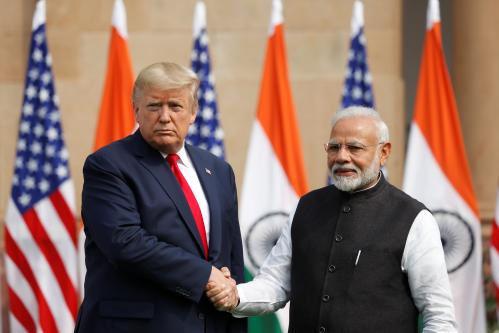Content from the Brookings Institution India Center is now archived. After seven years of an impactful partnership, as of September 11, 2020, Brookings India is now the Centre for Social and Economic Progress, an independent public policy institution based in India.
Connectivity is a prime factor in determining livability, employment and growth in a country. In this view, a well-connected India provides the prospect of a better India—from better access to services to better livelihoods and opportunities. Setting out to understand how connectivity in India had improved over time, we decided to track advances in three basic pillars of infrastructure and access – Roads, Teledensity and Electricity. In doing so, we relied on open-source government data to understand trends across time and states (and, where possible, districts).
The literature on the connection between all three pillars of infrastructure and economic growth is well-documented. Research shows that accessible and equitable infrastructure has long-term economic benefits. It can raise economic growth and productivity while having significant positive spillovers in increasing access to labour markets and reducing transaction costs.
Roads link producers to markets, workers to jobs, students to schools and patients to hospitals. The poorer a country is, the greater is the need for transport to support development. Findings across studies confirm the simple beliefs — better transport leads to better economic outcomes (Berg et al, 2015). Historically, infrastructure-building coincided with periods of rapid economic growth in Western Europe, Japan, China and the United States (Banerjee, Duflo & Qian 2012, Pradhan et al 2013). Similar results have also been found in the Indian context (Sahoo, Dash (2009), Donaldson 2018). To analyse time-trends on road transport networks, we relied on data from the Ministry of Statistics & Program Implementation (MOSPI).
Teledensity in rural India in 2001 was 0.93 per cent; in 2014, this number reached 44.01 per cent. The expansion of mobiles and telephones has uniquely positioned India as one of the biggest telecom markets in the world so much so that teledensity has emerged as an important parameter to assess inclusivity, growth and development across states. As the push for Digital India continues, states that are uniquely positioned with strong rural and urban penetration of telephones and mobiles stand to gain the most. In analysing teledensity data, we relied on estimates from MOSPI and Data.gov.in.
While trying to understand electricity access over the years, we had trouble finding credible government indicators that were disaggregated at least at a state-level to do a comparative analysis. Given this, we decided to use night-lights or luminosity data from NASA. The link between luminosity and economic activity has long been established. For countries with poor data, night-lights have been particularly useful in estimating the level of economic activity and gross domestic product (GDP). In fact, a study measuring rural electrification in India found that luminosity measures derived from satellite data were surprisingly accurate for measuring rural electrification, even at the village level and using simple statistical tools (Dugoua, Kennedy, Urpelainen 2018).
The Status of Connectivity in India
Roads:
As per data obtained by MOSPI, road connectivity in the form of road length consistently increased in the period between 2009 and 2015. In 2009, the total road length in India was 44,71,510 kilometers, as compared to 54,72,144 kilometers in 2015. Beyond metrics of basic road length, we also analysed road density, defined as the number of kilometers of road per 100 square kilometers of land. Across road density as well, we see a consistently upward trend between 2009 and 2015, particularly in the period following 2012. We see the most notable increase in the expansion of rural roads, where we see nearly a 41 per cent increase between 2009 and 2015. Out of all states, Bihar, Maharashtra, Madhya Pradesh and Assam stand out the most, with road connectivity improving significantly in the six-year period examined, especially between 2012 and 2013.

 Teledensity:
Teledensity:
Our analysis of teledensity data for a 12-year period between 2009 and 2017 for the states available also showed an upward trend. Teledensity grew by a whopping 136 per cent between 2009 and 2017. While Delhi remains a top performer given the size and population of the state, a trend analysis shows massive improvements in the states of Jammu & Kashmir, Himachal Pradesh and Uttar Pradesh. Assam, Bihar and Madhya Pradesh lag behind the states for which data was analysed and available in terms of teledensity.[1]

 Electricity:
Electricity:
Given the paucity of data on electricity access over time, we relied on using night-lights and luminosity data collected by NASA. Night-lights data comprises of data on energy emitted or reflected back from the surface of the earth to the sky. This is captured across all regions of the world by NASA and made available on their website. The data remains the most disaggregated of all three parameters studied, as it is available at the district level and for the longest time period, a timeframe of more than 20 years, from 1992 to 2013. Monthly nightlights data is also available from April 2012 to March 2018 and was also analysed. Overtime, we see luminosity in India substantially increased. Interestingly, a simple heat map analysis also shows that luminosity tends to correlate with economic activity where the areas of Delhi, Maharashtra and Gujarat show much brighter lights than states such as Odisha, Rajasthan and Madhya Pradesh.

While relying on single yardsticks of measures has limitations, such time-trends have the potential to show progress, no matter how basic or rudimentary. Though our analysis is fairly limited by the availability of government data and on the reliance of open-source data, such a time-series analysis is increasingly relevant in today’s India as basic infrastructure becomes a front and center policy issue.
[1] Data for all North-Eastern states (except Assam,) Jharkhand, Uttarakhand was not available in an aggregate format for the years considered.
Bibliography:
1. Berg, Claudia N.; Deichmann, Uwe Klaus; Liu, Yishen; Selod, Harris. 2015. Transport policies and development (English). Policy Research working paper; no. WPS 7366; Paper is funded by the Knowledge for Change Program (KCP); Paper is funded by the Strategic Research Program (SRP). Washington, D.C.: World Bank Group.
2. Banerjee, A., Duflo, E., & Qian, N. (2012). On the road: Access to transportation infrastructure and economic growth in China (No. w17897). National Bureau of Economic Research.
3. Pradhan, R. P., & Bagchi, T. P. (2013). Effect of transportation infrastructure on economic growth in India: the VECM approach. Research in Transportation Economics, 38(1), 139-148.
4. Sahoo, P., & Dash, R. K. (2009). Infrastructure development and economic growth in India. Journal of the Asia Pacific economy, 14(4), 351-365.
5. Donaldson, Dave. 2018. “Railroads of the Raj: Estimating the Impact of Transportation Infrastructure.” American Economic Review, 108 (4-5): 899-934.
6. Dugoua, E., Kennedy, R., & Urpelainen, J. (2018). Satellite data for the social sciences: measuring rural electrification with night-time lights. International Journal of Remote Sensing, 39(9), 2690-2701.
The Brookings Institution is committed to quality, independence, and impact.
We are supported by a diverse array of funders. In line with our values and policies, each Brookings publication represents the sole views of its author(s).



Commentary
Connecting India: How roads, teledensity and electricity have improved over time
October 30, 2018